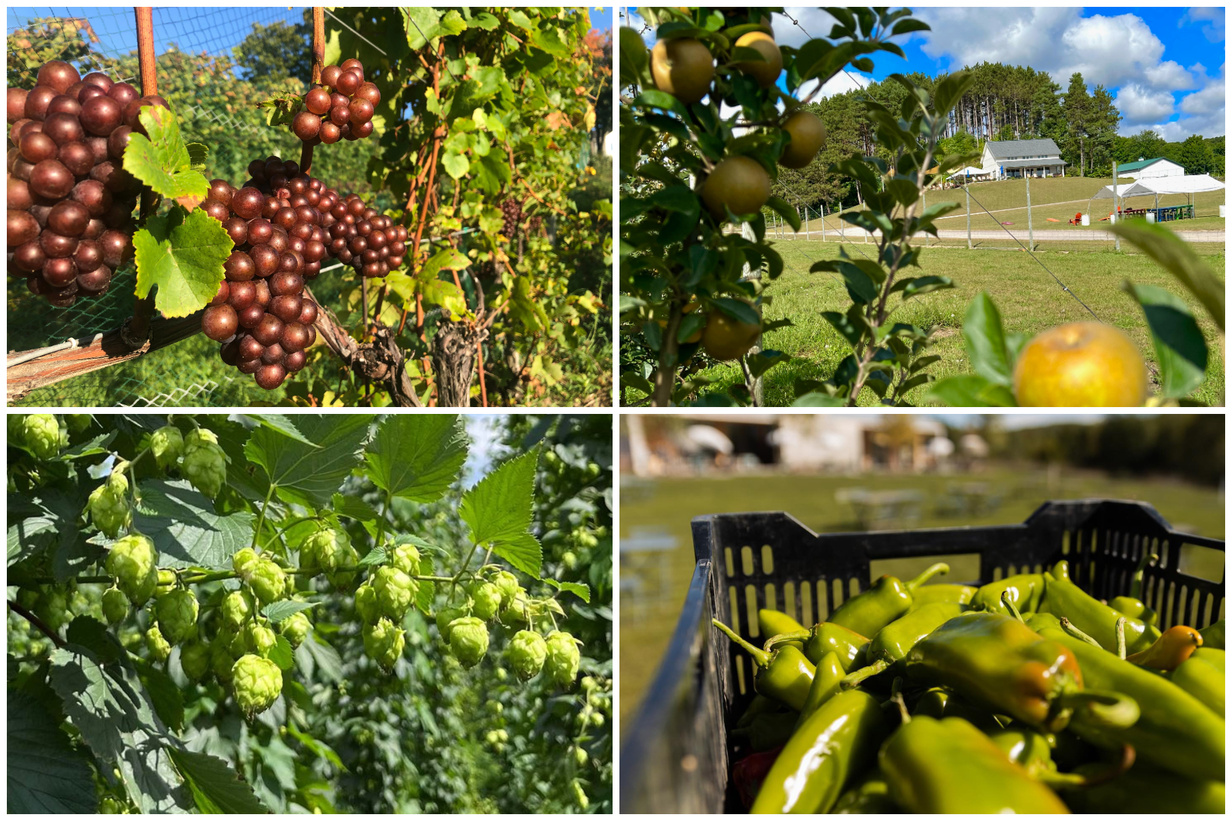
Tales From Harvest Season 2022
By Craig Manning | Oct. 9, 2022
Summer might be the season for Traverse City’s most iconic crop, but autumn seea a slew of other goods – from apples to hops to wine grapes – coming off the trees and vines. To celebrate fall harvest 2022, The Ticker checks in with four local growers to hear about one of the biggest apple crops ever, what wines are at risk from weather, and what’s new in northern Michigan agriculture.
Mari Vineyards
Will 2022 go down as a good or bad year for northern Michigan wine? Even with the key harvest month of October almost a third gone, Mari Vineyards Winemaker Sean O’Keefe tells The Ticker that much remains to be seen about how this year’s vintages will turn out.
The good news, O’Keefe says, is that local wineries have already dodged their biggest bullet, and they dodged it months ago. “Every wine region has its thing,” he says of major crop threats. “Out west, it’s forest fires. In France, it’s frost in the north and hail in the south. Here, it’s a really cold winter. And we’ve had mild winters for a few years in a row now.”
The bad news? Heavy rain in September, which O’Keefe says has brought significant “disease pressure” for local wineries. Substantial rain so late in the growing cycle causes grapes to swell up and increases risk of fungus or mildew. That’s not game over for growers, but it does mean that October weather matters more than it would in a year with a warmer, sunnier, drier September. The key now, O’Keefe notes, is warm October days (which allow sugar to build up in the grapes) bracketed by cool nights (which help the grapes maintain their acidity and minimize risk of rot).
“Every day of warmth above 55 is critical, because that’s when grapes accumulate sugar and decrease acids," O’Keefe explains. "I think the whites are going to be fine, and the early reds like Pinot Noir. But Cabernet Franc and other reds that are late ripeners, those are going to be nail-biters this year.”
Two K Farms
With more than 35 apple varieties and “one of the largest plantings of heritage high-density apple trees in the Midwest,” Two K Farms Cidery & Winery in Suttons Bay has a lot of work to do in any given harvest season. That’s especially true this fall when, according to VP of Operations Max Koskela, the farm is currently dealing with one of its biggest apple crops ever.
“It’s a very large apple crop in general, ours and the entire state of Michigan” Koskela says. “I think they were saying it’s going to be almost 30 million bushels, which is twice the amount of last year. We had very little frost in the spring, so that really helped the fruit. As a result, we have one of the biggest crops we’ve ever had.”
A large apple crop opens up big possibilities for a cidery like Two K. “We do a lot of single varietals, where everything we do is vintage-based,” Koskela explains. “That means what we produce in any given year is what the orchard gives us. We’re very different than a lot of other cider producers, which just buy fruit and manufacture every month, almost like a brewery. Ours is a winery approach, so we harvest and press all the fruit in the fall, and then ready many of our ciders for release in the spring.”
Overall, Koskela tells The Ticker that a bigger crop just means more: More fruit on the trees, more of each cider varietal, and more of the 2022 vintage across the board. “We may also have some new varietals,” Koskela adds, noting that extra apples can give Two K a little more freedom to experiment with new recipes and ideas. “But for the most part, this big crop just means there’s going to be more graft-to-glass cider available from us this year.”
MI Local Hops
The apple crop wasn’t the only one that got a big boost in 2022. According to Mike Moran, president of the Williamsburg-based MI Local Hops, the hop harvest this season was significantly up from 2021.
“Last year was a really down year,” Moran says. “Some hop varieties were down anywhere from 60-70 percent. So it was pretty important for us to get things like weed pressure down this year. We attacked that in the fall and as a result of staying on it, we increased our yields in some varieties and brought other varieties back to par.”
Michigan brewers are increasingly interested in utilizing exclusively Michigan ingredients. A down year for hop production makes that difficult, especially when it impacts a farm like MI Local Hops, which Moran says is the largest hop farm in the entire state. “We’re 220 acres and I think the next biggest farm is 90 acres,” he notes. Moreover, Moran says the hop varieties that were suffering most last year – craft beer staples like Centennial hops or Chinook hops – tend to be “heavy sellers in our market in the Midwest.”
Beyond boosting yields, MI Local Hops is also striving to improve Michigan’s position in the hop market by growing newer and less popular (for now) hop varieties. Some of the most popular hop varieties in craft beer – such as Citra, Mosaic, or Simcoe – are proprietary hops that can only be grown by certain farms. As a result, breweries looking for those hops have to buy them from Pacific Northwest suppliers. The Hop Breeding Program, a partnership between the Brewers Association and the United States Department of Agriculture, funds public hop breeding for the purpose of moving the beer industry beyond proprietary hops. Per Moran, MI Local Hops has several of those varieties “in the ground” right now and is working with local brewery partners like Stone Hound Brewing to get them into the market.
Loma Farm
At Loma Farm, harvest season is a year-round proposition. “There isn’t a month where we aren’t harvesting something,” says Nic Theisen, who owns Loma along with his wife Sara. “Collard greens and kale, we’ll harvest those into January, sometimes from underneath a foot or more of snow. And there have been years where we’ve been chiseling the frozen soil from the outside of leeks.”
Still, fall remains Loma’s busiest harvest stretch. That’s partially because there’s a race against the clock to harvest all the remnants of popular summer seasonals (like tomatoes or peppers) as well as other less hardy crops (such as chicory greens) before frost, freeze, or snow hits. The other big priority is banking enough food in Loma’s coolers to ensure a vibrant and varied wintertime menu for Farm Club, the affiliated restaurant that the Theisens also co-own.
With certain other crops, like Brussels sprouts or cabbage, Theisen tries to delay harvest as deep into fall or winter as possible. More time in the field, he says, means less time in storage, which can make the difference between Farm Club running out of ingredients in February and having a stable of good produce through the end of winter.
“During the summer, the day we harvest a crop it goes over to Farm Club and is used on the menu,” Theisen says. “But this time of year, we’re thinking months out. What should we use right now because it’s not going to last? What can we keep and squirrel away that will be good in February, March, or April? Harvest season, for us, is about constantly planning so that we not only have enough food to get us through the winter, but also so that we can keep the menu interesting, keep it delicious, and keep it truly ours and local food.”
Comment






